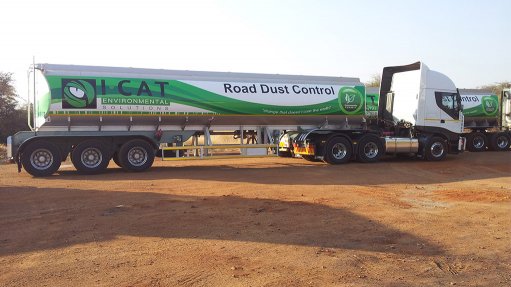
REDUCE YOUR USE Dust-suppression systems aid in the reduction of costly water use for mining operations
Environmental compliance is extremely important in the mining industry, owing to the fact that dust suppression affects not only the health and safety of mineworkers, but that of surrounding communities as well.
Another factor is that mines often use water as a solution to suppress dust. This is costly owing to the fact that water only suppresses dust for a short while, I-Cat environmental manager Rachelle Botha points out. “Dust-suppression systems aid in the reduction of water use – a current environmental issue, especially in the Western Cape.”
This, in effect, assists with water licences for mines, and reduces the long-term costs associated with excessive water use. Dust suppression on mines is important in promoting environmental compliance, but is also crucial as dust fall-out affects the air quality for not only mineworkers, but also for surrounding communities and plant life.
Breathing in dust can result in a range of occupational illnesses and diseases, depending on the size and composition of the dust particles, their effect on the body, the concentration in the breathing zone of the worker, and how often and how long a person breathes in the dust. Most dust clouds contain particles of widely varying sizes. Hazardous dust is not always visible.
A related impact of dust is safety, as high dust levels can reduce visibility, and thereby become a safety hazard.
“Coal dust is also an important cause of underground explosions. Preventing underground explosions and their catastrophic consequences must always be a high priority in all mining operations, particularly underground coal mining operations,” Botha highlights.
Mining operations are required to comply with the National Dust Control Regulation Act and the National Environmental Management Air Quality Control Act, No 36 of 2004, which make provision for dust-control management or air-quality control.
“These regulations ensure that mines comply in order to protect mineworkers and surrounding communities in terms of health and safety, as dust emission is an air pollutant,” Botha stresses.
I-Cat is a leading designer and manufacturer of dust-suppression systems for mining operations. “We conduct extensive research and development on our products prior to placing them on the market. We test our products on numerous different soil samples in the field, and we have developed products that have shown very positive results,” states I-Cat dust division project manager Wessel van der Westhuizen.
As an environmental solutions company, I-Cat has several divisions that focus on many aspects of dust management, such as road haulage, water, and legal and environmental compliance.
“Most of our products are environment-friendly, and are certified by Eco Specifier. We keep on innovating and developing products that provide total dust-management solutions that comply with national and international ‘green’ standards,” concludes Van der Westhuizen.